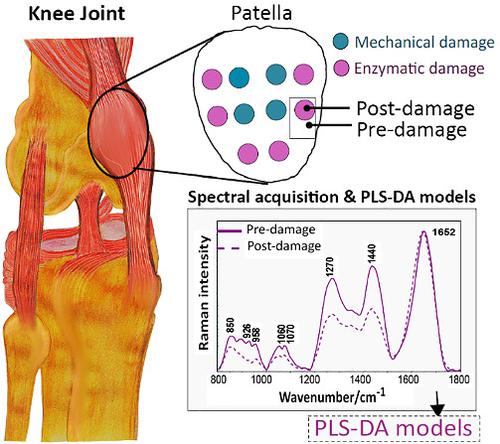当前位置:
X-MOL 学术
›
J. Raman Spectrosc.
›
论文详情
Our official English website, www.x-mol.net, welcomes your feedback! (Note: you will need to create a separate account there.)
Raman spectroscopy is sensitive to biochemical changes related to various cartilage injuries
Journal of Raman Spectroscopy ( IF 2.5 ) Pub Date : 2021-01-07 , DOI: 10.1002/jrs.6062 Rubina Shaikh 1, 2 , Ervin Nippolainen 1, 2 , Vesa Virtanen 3 , Jari Torniainen 1 , Lassi Rieppo 3 , Simo Saarakkala 3, 4 , Isaac O. Afara 1, 5 , Juha Töyräs 1, 5, 6
Journal of Raman Spectroscopy ( IF 2.5 ) Pub Date : 2021-01-07 , DOI: 10.1002/jrs.6062 Rubina Shaikh 1, 2 , Ervin Nippolainen 1, 2 , Vesa Virtanen 3 , Jari Torniainen 1 , Lassi Rieppo 3 , Simo Saarakkala 3, 4 , Isaac O. Afara 1, 5 , Juha Töyräs 1, 5, 6
Affiliation

|
Raman spectroscopy is promising in vivo tool in various biomedical applications; moreover, in recent years, its use for characterizing articular cartilage degeneration has been developing. It has also shown potential for scoring the severity of cartilage lesions, which could be useful in determining the optimal treatment strategy during cartilage repair surgery. However, the effect of different cartilage injury types on Raman spectra is unknown. This study aims to investigate the potential of Raman spectroscopy for detecting changes in cartilage due to different injury types. Artificial injuries were induced in cartilage samples using established mechanical and enzymatic approaches to mimic trauma‐induced and natural degeneration. Mechanical damage was induced using surface abrasion (ABR, n = 12) or impact loading (IMP, n = 12), while enzymatic damage was induced using three different treatments: 30 min trypsin digestion (T30, n = 12), 90 min collagenase digestion (C90, n = 12), and 24 h collagenase digestion (C24, n = 12). Raman spectra were obtained from all specimens, and partial least squares discriminant analysis (PLS‐DA) was used to distinguish cartilage injury types from their respective controls. PLS‐DA cross‐validation accuracies were higher for C24 (88%) and IMP (79%) than for C90 (67%), T30 (63%), and ABR (58%) groups. This study indicates that Raman spectroscopy, combined with multivariate analysis, can discern different cartilage injury types. This knowledge could be useful in clinical decision‐making, for example, selecting the optimal treatment remedy during cartilage repair surgery.
中文翻译:

拉曼光谱对与各种软骨损伤相关的生化变化敏感
拉曼光谱法在各种生物医学应用中是有前途的体内工具。此外,近年来,其用于表征关节软骨变性的用途已经得到发展。它还显示了对软骨病变严重程度进行评分的潜力,这可能有助于确定软骨修复手术中的最佳治疗策略。然而,未知不同软骨损伤类型对拉曼光谱的影响。这项研究旨在调查拉曼光谱法检测由于不同损伤类型引起的软骨变化的潜力。使用已建立的机械和酶学方法模拟创伤引起的自然退化,从而在软骨样品中诱发人为伤害。机械磨损是由表面磨损引起的(ABR,n =12)或冲击负荷(IMP,n = 12),同时使用三种不同的处理方法诱发了酶损伤:30分钟的胰蛋白酶消化(T30,n = 12),90分钟的胶原酶消化(C90,n = 12)和24小时胶原酶消化(C24,n =12)。从所有标本中获得拉曼光谱,并使用偏最小二乘判别分析(PLS-DA)来区分软骨损伤类型与它们各自的对照。C24(88%)和IMP(79%)的PLS‐DA交叉验证准确性高于C90(67%),T30(63%)和ABR(58%)组。这项研究表明,拉曼光谱法与多变量分析相结合,可以识别出不同类型的软骨损伤。这些知识可能有助于临床决策,例如,在软骨修复手术中选择最佳治疗方法。
更新日期:2021-01-07
中文翻译:

拉曼光谱对与各种软骨损伤相关的生化变化敏感
拉曼光谱法在各种生物医学应用中是有前途的体内工具。此外,近年来,其用于表征关节软骨变性的用途已经得到发展。它还显示了对软骨病变严重程度进行评分的潜力,这可能有助于确定软骨修复手术中的最佳治疗策略。然而,未知不同软骨损伤类型对拉曼光谱的影响。这项研究旨在调查拉曼光谱法检测由于不同损伤类型引起的软骨变化的潜力。使用已建立的机械和酶学方法模拟创伤引起的自然退化,从而在软骨样品中诱发人为伤害。机械磨损是由表面磨损引起的(ABR,n =12)或冲击负荷(IMP,n = 12),同时使用三种不同的处理方法诱发了酶损伤:30分钟的胰蛋白酶消化(T30,n = 12),90分钟的胶原酶消化(C90,n = 12)和24小时胶原酶消化(C24,n =12)。从所有标本中获得拉曼光谱,并使用偏最小二乘判别分析(PLS-DA)来区分软骨损伤类型与它们各自的对照。C24(88%)和IMP(79%)的PLS‐DA交叉验证准确性高于C90(67%),T30(63%)和ABR(58%)组。这项研究表明,拉曼光谱法与多变量分析相结合,可以识别出不同类型的软骨损伤。这些知识可能有助于临床决策,例如,在软骨修复手术中选择最佳治疗方法。


























 京公网安备 11010802027423号
京公网安备 11010802027423号